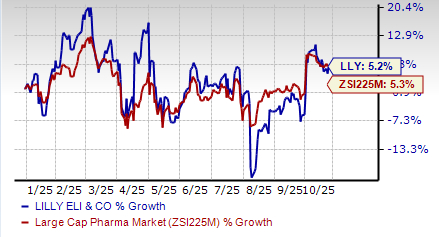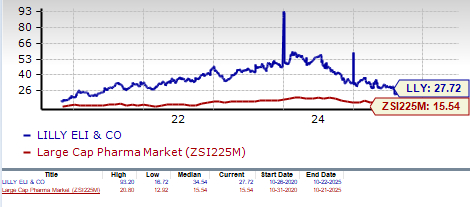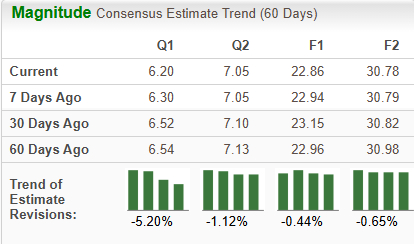|
|
|

|
|||||

|
|
Eli Lilly and Company’s LLY stock has risen 9.5% in a month, mainly due to the recent recovery in the pharma sector. The drug and biotech sector has recovered in the past month, with large drugmakers like Pfizer PFE and AstraZeneca AZN signing drug pricing agreements with the Trump administration. PFE and AZN have offered to cut prescription drug prices and boost domestic investments in exchange for a three-year exemption from tariffs on pharmaceutical imports.
The deals between PFE and AZN and the Trump administration have raised hopes of a sustainable sector recovery, with the President offering to hold off the tariffs on pharmaceutical imports to sign similar deals with other drugmakers. Lilly could well be the next to sign a similar deal with the U.S. government, as it has already committed over $50 billion for domestic manufacturing expansion.
The recovery in the drug and biotech sector has left investors confused as to how to play the stock. Let’s understand LLY’s strengths and weaknesses to make an informed decision.
Lilly boasts a robust portfolio of treatments for diabetes and other cardiometabolic conditions, with its cardiometabolic division emerging as the company’s strongest segment. This success is largely attributed to its widely used GLP-1 therapies — Mounjaro for diabetes and Zepbound for weight loss.
Despite being on the market for only around three years, Mounjaro and Zepbound have become key top-line drivers for Lilly, with demand rising rapidly. Mounjaro and Zepbound account for around 50% of the company’s total revenues.
Launches of these drugs in new international markets and improved supply from ramped-up production in the United States led to strong sales in the first half of 2025. The positive trend is expected to continue in the second half. Regulatory approvals for new indications and improved production capacity are expected to boost sales further.
Lilly is investing broadly in obesity and has several new molecules currently in clinical development with a range of oral and injectable medications with different mechanisms of action. These include two late-stage candidates, orforglipron, a once-daily oral GLP-1 small molecule, and retatrutide, a GGG tri-agonist and some mid-stage candidates, bimagrumab, eloralintide and mazdutide.
Lilly has announced mixed data from two studies on orforglipron in obesity. An oral pill like orforglipron has the potential to be a more convenient alternative to injectable treatments like Zepbound and rival Novo Nordisk’s NVO Wegovy. Lilly plans to file regulatory applications for orforglipron in obesity later this year, setting up the timeline for a potential launch next year.
It is also evaluating orforglipron in late-stage studies in other disease areas like obstructive sleep apnea and hypertension. It also expects the first data readout from a phase III study on its triple-acting incretin, retatrutide (which combines GLP-1, GIP and glucagon), in osteoarthritis of the knees later in 2025.
LLY is also working to diversify beyond GLP-1 drugs by expanding into cardiovascular, oncology, and neuroscience areas. In 2025, it announced three M&A deals. It acquired Verve Therapeutics to add gene therapies for heart disease to its pipeline. Lilly has also entered into agreements to acquire Scorpion Therapeutics’ oncology drug and SiteOne Therapeutics’ non-opioid pain candidate.
In addition to Mounjaro and Zepbound, Lilly has secured approvals for several other new therapies over the past few years. These include Omvoh for treating ulcerative colitis and Crohn’s disease, BTK inhibitor Jaypirca for mantle cell lymphoma and chronic lymphocytic leukemia, Ebglyss for moderate-to-severe atopic dermatitis, and Kisunla (donanemab) for early symptomatic Alzheimer’s disease. These newly approved drugs are also contributing to Lilly’s revenue growth. Inluriyo (imlunestrant) was approved in the United States for treating ER+, HER2-, ESR1-mutated advanced or metastatic breast cancer last month.
Lilly expects its new drugs, Mounjaro, Zepbound, Omvoh, Jaypirca, Ebglyss and Kisunla, along with the expanded use of existing drugs, to drive sales growth in the second half of 2025.
The obesity market is expected to expand to $100 billion by 2030, according to data from Goldman Sachs, which means fierce competition is inevitable. Lilly and Novo Nordisk presently dominate the market.
Mounjaro and Zepbound face strong competition from Novo Nordisk’s semaglutide medicines, Ozempic for diabetes and Wegovy for obesity.
U.S. President Donald Trump signaled potential steep price cuts for GLP-1 drugs during a White House event last week. At the event, Trump said that the prices of popular weight loss drugs like NVO’s Ozempic, once negotiated, could drop to around $150 out-of-pocket for Americans. However, the government has not yet started formal negotiations on the prices of brand-name GLP-1 drugs, but confirmed the process will be rolled out over time.
Though Trump did not specify Lilly’s GLP-1 therapies, Mounjaro and Zepbound, investors fear that they may face similar pricing pressure once negotiations with the government begin. Although Ozempic and Mounjaro are approved to treat diabetes, they are frequently prescribed off-label for obesity. NVO’s Wegovy and Zepbound are approved for treating obesity.
Several other companies, like Amgen and Viking Therapeutics VKTX, are also making rapid progress in the development of more potent and convenient GLP-1-based candidates in their clinical pipeline.
NVO, LLY and VKTX are racing to introduce oral weight-loss pills, as Wegovy and Zepbound are both injectable drugs. Novo Nordisk has already filed a new drug application (NDA) for an oral version of Wegovy and also has several next-generation candidates in its obesity pipeline, like CagriSema (a combination of semaglutide and cagrilintide) and an oral pill, amycretin (a dual GLP-1 and amylin receptor agonist). The FDA is expected to decide on the Wegovy oral formulation NDA later this year.
Viking Therapeutics’ dual GIPR/GLP-1 receptor agonist, VK2735, is being developed both as oral and subcutaneous formulations for the treatment of obesity. In the third quarter, the company announced mixed top-line results from a mid-stage study evaluating the safety and efficacy of the oral formulation of VK2735. Though patients on the highest drug dose lost up to 12.2% of their body weight after 13 weeks of daily dosing compared with 1.3% in the placebo group, a significant number of patients also dropped out of the study. Phase III obesity studies with the subcutaneous formulation of VK2735 have also been initiated.
Lilly’s stock has risen 5.2% so far this year compared with the industry’s increase of 5.3%.

From a valuation standpoint, Lilly’s stock is expensive. Going by the price/earnings ratio, LLY’s shares currently trade at 27.72 forward earnings, much higher than 15.54 for the industry. However, LLY’s stock is trading below its 5-year mean of 34.54.

The Zacks Consensus Estimate for 2025 has declined from $23.15 per share to $22.86 per share over the past 30 days, while that for 2026 has declined from $30.82 to $30.78 per share over the same timeframe.

Lilly’s tremendous success with Mounjaro and Zepbound has made it the largest drugmaker with a market cap of more than $750 billion, and its stock price is more than $800 per share.
However, despite its expensive valuation, Lilly is a great stock to have in one’s portfolio, considering its product and pipeline portfolio in high-growth therapeutic areas like obesity, robust growth prospects and bullish analyst sentiment. In 2025, Lilly expects to record revenues in the range of $60.0 billion to $62.0 billion, indicating an impressive year-over-year growth of more than 30%.
Investors who own this Zacks Rank #3 (Hold) stock should retain it. You can see the complete list of today’s Zacks #1 Rank (Strong Buy) stocks here.
Want the latest recommendations from Zacks Investment Research? Today, you can download 7 Best Stocks for the Next 30 Days. Click to get this free report
This article originally published on Zacks Investment Research (zacks.com).
| 4 hours | |
| 7 hours | |
| 9 hours | |
| 13 hours | |
| 15 hours | |
| Dec-24 | |
| Dec-24 | |
| Dec-24 | |
| Dec-24 | |
| Dec-24 | |
| Dec-24 | |
| Dec-23 |
The U.S. Offered Putins Closest Ally Sanctions Reliefand a Weight-Loss Drug
LLY
The Wall Street Journal
|
| Dec-23 | |
| Dec-23 | |
| Dec-23 |
Join thousands of traders who make more informed decisions with our premium features. Real-time quotes, advanced visualizations, backtesting, and much more.
Learn more about FINVIZ*Elite